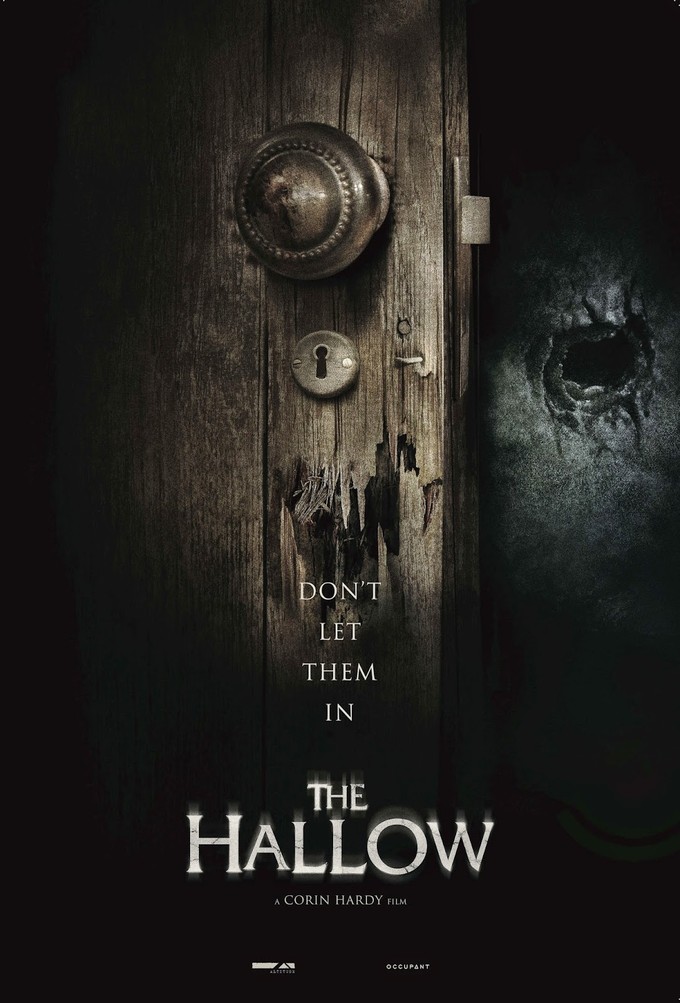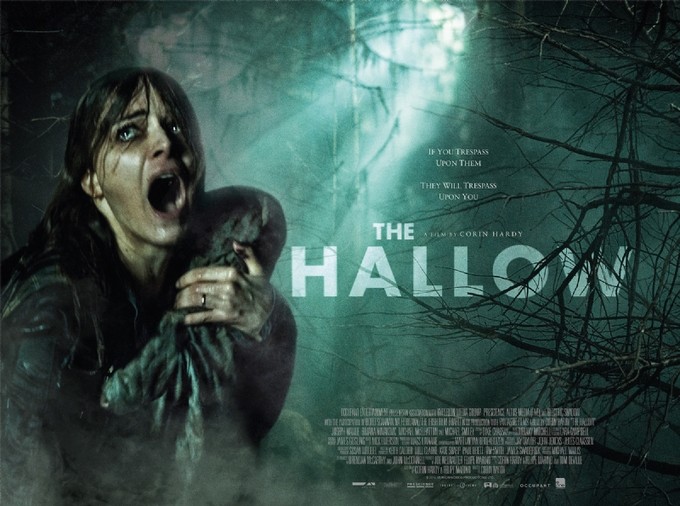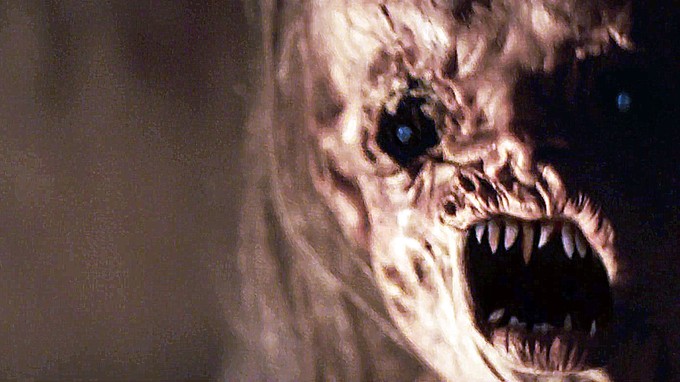
Corin Hardy’s debut film THE HALLOW is the type of horror movie that manages to both give you what you paid for while still managing to surprise you. It initially seems to be a horror-themed riff on STRAW DOGS, with a British couple (Joseph Mawle and Bojana Novakovic) traveling to a hostile Irish town for the husband’s job, before encountering some mysterious woodland happenings while clearing out some of the local forest. While it’s obvious that there is something to the ominous occurances (as one character says, “This isn’t the city; here, things do go bump in the night”), what isn’t as evident at the outset how closely it will affect the man and wife, and what kind of danger their young son is in.
Using the woody scenery, a savvy sense of atmosphere, and a great collection of practical FX, Hardy presents a monster movie that feels more immediate and frightening than your usual "young couple in peril" scarer. The stakes here feel real, and there is a point reached where it’s obvious that none of the characters can emerge from this fully unscathed, forcing you to start thinking not of happy endings but of the best possible outcome for this family (none of them are great). It’s a dark, intense film, and a potent statement for what Hardy is shooting for as a filmmaker as well as what he brings to the table.
Read on for Corin’s thoughts on Ray Harryhausen, the difficulty of shooting nighttime exteriors, and his long-gestating take on THE CROW:

VINYARD: Let’s talk about the origin of this story. Is this based on actual folklore?
CORIN: I set out to make a contemporary horror movie based on some mythology. I was reading and researching different kinds of folklore from around the world, particularly Ireland. I was looking at the mythology. They were so many different kinds of fairy folklore, it was like neverending. The challenge was finding ideas and lore that could translate to a visceral, visual horror movie. It was a case of taking ideas and putting them together to create my own mythology.
VINYARD: I got a heavy STRAW DOGS influence from the structure, the setup, and the environment. Can you talk about some of the other things that were influencing you when you were writing the script?
CORIN: I’m a big fan of the ‘70s and ‘80s-era horror movies, the golden age, from THE EXORCIST to ALIEN to THE THING. I grew up watching Ray Harryhausen monster movies. I wanted to take a fresh approach to a creature, and wanted to explore the idea of what it could be to spend a night in the presence of fairies. Basically taking folklore into a visceral, real world. I took inspiration from movies like DELIVERANCE and STRAW DOGS in the way I grounded it in reality. I just wanted to combine that with something that ultimately became a fairy tale. When writing the script, it was a case of trying to take the mythology and trying to imagine what would be the truth behind it, finding a balance between folklore and scientific biology and science and nature.
VINYARD: You mentioned Ray Harryhausen. Did you have a personal relationship with him?
CORIN: I was only lucky enough to meet him like three times. When I was 17, I met him. I had to do an A-level art project, and I did a project on Ray Harryhausen. My father managed to contact him, he was living in London. Ray was such a lovely man that he invited me to his house in Kensington, and I got an interview as a 17-year-old that was really inspiring. I actually always wanted to be a monster maker. I spent my childhood in a back shed inventing creatures and experimenting with latex and making horror movies on super-8. Ray actually made a diamond lure out of an armature, and proudly took it to me. He was really critical in a good way, he took me seriously. He criticized my sculpting, specifically the weight and proportions of my T-rex. I was amazed that he took me seriously.
Again, a few years later, I had made my stop-motion movie called BUTTERFLY, which is a 16mm stop-motion project that took five years to make. Ray had seen it at a film festival, and I was lucky enough to have dinner with him. He was very awe-inspiring and passionate about his creations, and that always inspired me, so I put in a special thanks at the end of THE HALLOW to Ray Harryhausen, Dick Smith, and Stan Winston, the great pioneers of practical FX and creature makeup.
VINYARD: I know that the creatures aren’t stop-motion, but do you think Ray Harryhausen influenced your creature designs in any way?
CORIN: Yeah. People talk about the Ray Harryhausen sort of movement. It’s a particular characteristic. I probably used JASON & THE ARGONAUTS and CLASH OF THE TITANS for the skeleton movements or the power-walk. They have this sort of arched-shoulders, head-slumped-forward from the neck out- I can imitate the movement quite well. So when I was designing the creatures, it wasn’t direct, but it’s more just as a fan, in my blood. When you’re creating creatures, your looking at form and movement and body shape, so the creatures in my film are practical if possible, involving a mix of puppetry and in-camera techniques, prosthetic, animatronics, and visual effects. In doing that, I was trying to find ways of manipulating the human form to scare and terrify, and somewhere in there is the Ray Harryhausen creature pose.

VINYARD: The creatures have such a distinct look. Could you talk about working with your makeup designer to try and nail that look down, with all the spores and stuff?
CORIN: As a fan of monster movies, it was like this is my turn to try and create something that’ll hopefully be memorable. I wanted it to be scary, but I also wanted it to make sense within the narrative, because I was trying to translate fairy mythology and folklore into reality. The creatures…they weren’t like ghosts where they appear and reappear so you can betray logic, there has to be a throughline. Connecting a sort of semblance of parasitic fungal infection in a nature show I’d seen about cordyceps. I thought I could kind of do the look and breakdown of a sort of fungal infection, and mix that with concepts found in fairy folklore. The idea of being touched by feys in mythology sometimes will make a human go mad, or gain second sight, or find themselves in a different part of the forest from where they set out. The idea of being touched by a fairy, I had the idea that maybe that’s more than just a magical occurrence. It’s actually more like being infected by a fairy.
The narrative dictated the look of the creatures, but then I worked closely with…I wanted to find the U.K. equivalent of Rob Bottin or Stan Winston or Rick Baker in their prime, but now, which is quite a difficult task. I found a bloke called John Nolan, who has a small, dedicated team in London that work closely together. I designed the look of the creatures and had a lot of sketches and drawn concepts to try and put my mind on the page, and then worked with John and his team to make them real in the flesh.
VINYARD: It’s great ‘cause you only see them at night, and you have all these great night shots where you can just make them out. How was working with Martijn van Broekhuizen to get those exposures in the middle of the woods at night?
CORIN: That was critical. Martijn van Broekhuizen is this tremendous Dutch D.P. who I’d heard about from contemporaries of my production company, Academy Films in London. They recommended him. I wanted to try and make as many fresh choices when picking cast and crew on THE HALLOW. I didn’t necessarily want to go for people who were kind of horror people. Martijn hadn’t shot a horror film, Joe Mawle, the lead actor, wasn’t really a horror guy either. It was critical that we’d do everything as organically as possible, but we knew it’d be real nice to shoot in the forest at night. To try and find that balance where you create enough light and latitude to see, but cinematically so it doesn’t get too stylized. We didn’t do any of that when we did the interiors, where we actually built the house that we could shoot. It was a big challenge when we went out there in the forest of Ireland in the rain with people dressed in monster costumes cruising around.
Those films that I’ve mentioned, John Boorman movies, Ridley Scott’s ALIEN, the way light is used, particularly at nighttime and particularly in a monster movie, to help create the illusion and keep the mystery alive I think is critical. The movie takes place during both day and night, but the creatures have a relationship with the darkness and the forest, so my job was to move all my set pieces around the light source and the uncertainty of it. So there’s a lot of light sources failing, or flickering, in particular the use of flames. That helps when doing something practically, you need to not show it in its entirety. We storyboarded the whole movie, and worked closely with Martijn and his Dutch gaffer, who was a really incredible Dutchman who really pulled all the stops and worked incredibly hard to create this illusion.

VINYARD: The destruction of the forests themselves is a big theme of the movie. Is that something that’s important to you that you wanted to get across in the film?
CORIN: Well, yeah. I didn’t want to make some ecological statement movie, but I did think that it’s nice, particularly in genre movies, George Romero movies, where there’s this sort of connection to the times we live in. It was actually when writing the script, and who Adam would be and what the movie would be, it came naturally. When researching Ireland, we found they had this economic crisis and they were selling parts of their forests, and the idea of a conservationist from London being dropped into a job that he loved but that was sort of property, and he was sort of breaking his own rules from the start. I think the most important thing is finding the right story to tell within your idea. It helps when under-the-line there’s some sort of message, and the fairy mythology…there’s a book called The Book of Invasions, which is an interesting, ambiguous document. There might actually be two Books of Invasion. One’s a sort of history of Ireland, and the other is the mythology of Ireland and the first race there and how they drew them. The idea of humans destroying sacred land, and it comes back to haunt us and destroy us and take nature’s revenge on us was part of the same world of the movie I wanted to make. It wasn’t crowbarred in.
VINYARD: There’s also a lot of horror relating to the eye, which personally is something that freaks me out. Is that something that gets to you?
CORIN: Yeah. I’ve worn glasses all my life, since I was four-years-old. I’ve had all these eye tests and things poked in my eyes. I actually had, at one point, during some work doing propmaking when I was younger, I had a sort of eye infection, and had to have a needle injected into my pupil, which is terrifying. I think eyes are such a specific part of our body. They’re like an emotional gateway into our being and our souls. They are one of those parts of our bodies that, in horror movies, people don’t like being fucked with, like coming up with teeth being pulled out. It relates back to this idea of fairies and folklore, the idea of being touched by fairies and gaining second sight. It’s like an infection being introduced through the eyeballs and spreading under the skin. Body horror kind of came naturally into the idea of the movie. Like Jeff Goldblum in THE FLY, something emotional and tragic happening that takes place within the character. I was always looking for ways to incorporate something that would be scary but also have a logic to it, kind of a fantastical logic to it.
VINYARD: In the credits, you’re credited as a “Fake Shemp,” which is a reference to EVIL DEAD and Ted Raimi and those guys. You played a couple of creatures yourself?
CORIN: That was a nod to Sam Raimi and his credits in his movies. When you’re making a movie like this, you run into some funny stuff. You’re tracking the creature’s hand which is attacking the lead actress from offscreen, or having to get a closeup of someone’s hand reading a book, but you don’t have the actor there, or you have to get someone to stand-in out of focus for the lead actor. So I thought let me give some credit to the people who I’d noticed had to do a quick time trick, bolting the door lock, or like a one-second cutaway. Those were the Fake Shemps.
VINYARD: Was it fun at all doing that stuff?
CORIN: Oh yeah. Shemping? Yeah, it’s fun, but necessary fun. It wasn’t something I set out to do, more like it’s the end of the day and you need to quickly grab some pick-ups, so you grab someone and stick ‘em in there.

VINYARD: Obviously, that’s not the real baby for the bulk of the shots. Was it tricky to shoot around the baby without getting across that it was a prop or an animatronic?
CORIN: It was one of the most difficult things. You write a script, and you incorporate a baby in it, dogs, and night shoots, and everything, but I didn’t realize that the baby’s sort of the lead character, and spends almost 90% of the film onscreen. The process was, we had to cast a pair of twins the same age, who I wanted to appear to be about five or six months old, so in preproduction, in order to create a full, anatomically correct replica, we cast the baby two months before, when he was three months old. At the time, finding a pair of Irish twins in Ireland, close to the production, aged three months old was a bit of a task to begin with. We found a lovely couple with baby boys called James and Joe, and then we had to take a lot of photos of them to take to the special effects guys, who sculpted two life-size, correct weighted replicas that were fully animatronic. One was a jointed puppet, then there was a changeling. In total, we had three babies, one animatronic, one “stunt baby”, and one changeling.
Strangely enough, when I finally got the film off the ground, I actually had a baby myself. When I finished the shoot, I needed to do a little pickup of the opening, and it was five months later and the baby boys had grown up. My own daughter was then exactly five months old, and I was able to put her in the movie, standing in for the baby boys. So technically, there are six total. I’m really proud of the illusion, because you’re constantly seeing one of those six babies most of the time, and it’s a combination of the actors being able to manipulate the rubber puppet and you got guys standing off-screen with radio-control units controlling the animatronic. Other times, the babies actually had a great time and loved being on camera. The mum of the babies were there for every shot. It’s amazing when the babies were right there. They don’t bite, they’re actually just a little bit kind and would start to cry if you didn’t give them attention (laughs).
VINYARD: My last question is about THE CROW, which you’re still attached to. What’s the progress on that?
CORIN: It’ll be up soon. It’s absolutely going to happen, and I’m very much looking forward to continuing working on it. Our pre-production was interrupted by Relativity’s situation that everyone’s aware of, but everyone’s excited by what we’re creating, and I’m looking forward to continuing making THE CROW.
VINYARD: What’s your take on it, briefly?
CORIN: I’m a huge fan of both the original film and the graphic novel that James O’Barr created. It really appealed to me when I was 17, the balance of emotional depth and exciting revenge and romance and gothic qualities. If there wasn’t the graphic novel, I wouldn’t be trying to remake that film, ‘cause that film was a perfect piece. We’re going back to that, and exploring a lot more in-depth to bring my take from James O’Barr’s graphic novel.
VINYARD: Will the Skull Cowboy be making an appearance?
CORIN: (laughs) That’s seriously the main question that everyone keeps asking me. There’s lots of cool details that we’ll be seeing.
THE HALLOW is currently available on VOD, and plays the IFC theater this week before expanding to the Arena Theater in L.A. on the 13th.
